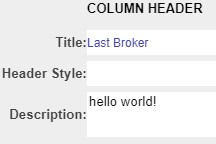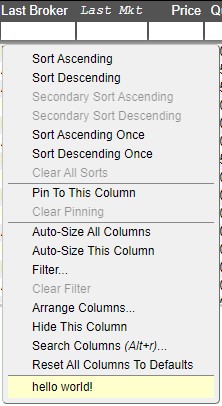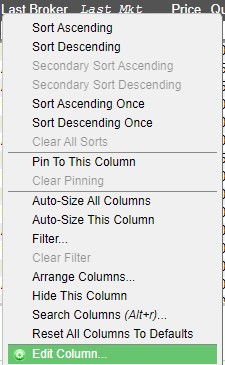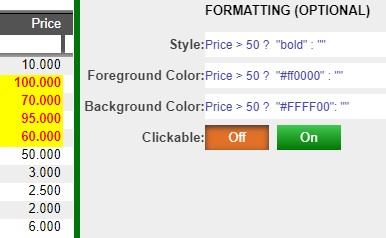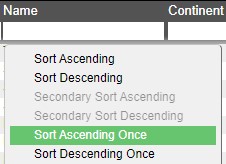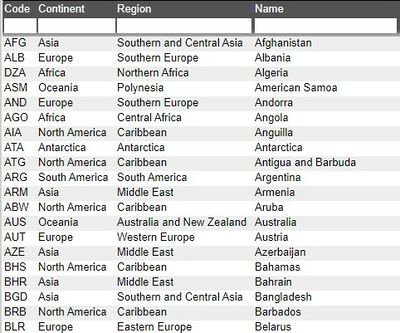GUI Tables
Columns
Adding, Editing, Copying, & Deleting Columns
Adding
(Note: these options are only available when in developer mode)
There are three ways to add columns in tables
1. Click on the green button to bring up the panel configuration menu and select Add Column
2. Click on a column to bring up the column menu. This method allows you to place the new column in between existing columns. In the menu, select whether to add the new column to the right or left of the selected column
3. Click on an open area of the header in order to bring up the header menu. In the menu, select Add Column.
Add Column menu
| Display | Use variables, operators, functions, and icons to create the content for the column |
| Sorting | Use variables, operators, and functions to apply a sorting to the contents of the column |
| Format | Choose the format of the column (e.g.: text, numeric, time, date, price, etc.) |
| Title | Create a title for the new column. Must be unique from existing columns. |
| Header Style | Apply different fonts, alignments, style, and colors to the column header |
| Description | Add a description/help which can be seen when clicking on the column header |
| Column Position | Drop down list of various positions where the new column can be placed (can also be hidden) |
| Style | Apply a style to the contents of the column (including font and alignment) |
| Foreground Color | Apply a color to the contents of the column |
| Background Color | Apply a background color to the column |
| Clickable | Makes the contents of the column clickable |
Examples
Adjusting header and column styles
Column Description
Editing
There are two ways to edit columns
1. Click on the header of the column to bring up the column menu and select Edit Column
2. Click on the green button to bring up the panel configuration menu. Highlight Edit Column to bring up the list of columns and select the column
Both options will open the Edit Column window, which is the same as the Add Column window.
Example
Conditional Formatting
Formatting can be used to highlight data in specific formats when certain parameters are met. In this example, the Price is set to be in bold red and highlighted if it is greater than $50.
Copying
In order to copy a column, click on the column to be copied and select Copy Column. This will bring up the Edit Column menu. Apply a different name and click Update.
Note: if the column to be copied has any input in its fields, those fields will also be copied.
Sorting & Pinning
Columns can be sorted in multiple ways
Primary Sorting
Primary sorting will remain in place until it is cleared. Any new data added to the table will automatically be sorted. There are two ways to add a primary sort to a column.
1. Click on a column to open the column menu. Select either Sort Ascending or Sort Descending
2. Hover over the column header - this will bring up the sorting arrows on the right side of the header. Clicking on the up arrow will apply a sort in ascending order & clicking the down arrow will apply a sort in descending order
After applying a primary sort, the corresponding arrow indicating the type of sort will appear in the header
Application of a descending sort
In order to cancel a primary sort on a single column, use the Sort Ascending Once or Sort Descending Once options from the column menu. This will perform a sort which will not remain in place and the primary sort will no longer be applied to the column.
Secondary Sort
Secondary sort can be used to further sort the data based on multiple columns. The secondary sort option will not be available unless there is a primary sort in place on one of the columns.
Example





